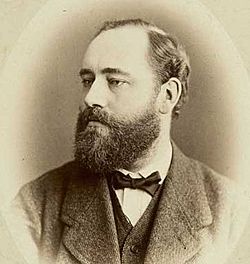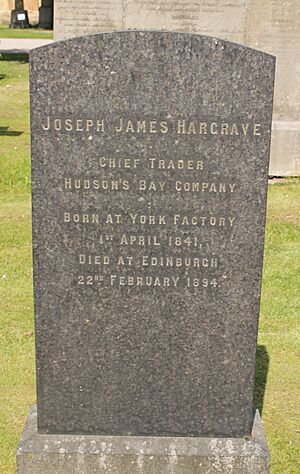Joseph James Hargrave facts for kids
Quick facts for kids
Joseph James Hargrave
|
|
|---|---|
 |
|
| Born | 1 April 1841 |
| Died | 22 February 1894 (aged 52) Edinburgh, Scotland
|
| Education | Madras College |
| Occupation | Fur trader, author, journalist |
| Employer | Hudson's Bay Company |
| Parent(s) |
|
Joseph James Hargrave (born April 1, 1841 – died February 22, 1894) was an important person who worked for the Hudson's Bay Company. He was a fur trader, a writer, and a journalist. He also held the title of Fellow of the Royal Geographical Society (FRGS).
About Joseph James Hargrave
Joseph James Hargrave was born in a place called York Factory on Hudson Bay. This was a busy fur trading post. He was the oldest son of James Hargrave, who was a Chief Trader there, and his mother, Letitia MacTavish Hargrave.
In 1846, when Joseph was five years old, his family moved to Scotland. There, he went to school at Madras College in St. Andrews. He finished his studies in 1859, learning how to be a surveyor. A surveyor is someone who measures and maps land.
Working for the Hudson's Bay Company
In 1861, Joseph Hargrave returned to North America. He started working for the Hudson's Bay Company (HBC) as an apprentice clerk. This meant he was learning the fur trading business. He also became a secretary to his uncle, William Mactavish. His uncle was the governor of two large areas called Rupert's Land and Assiniboia.
In 1869, Joseph began writing articles for a newspaper called the Montreal Herald. He wrote about how the HBC's land was going to be transferred to Canada. This was a big change for the country.
Writing the Book "Red River"
In 1871, Joseph Hargrave published his own book titled Red River. This book told the story of the Red River Colony. It described what life was like there before a major event called the Red River Rebellion. This rebellion involved a famous leader named Louis Riel.
Before he retired, Joseph Hargrave became a chief trader for the Hudson's Bay Company. This was a high-ranking position in the company. He passed away in 1894, not long after he had returned to Edinburgh, Scotland. He is buried in a place called Dean Cemetery in west Edinburgh.


